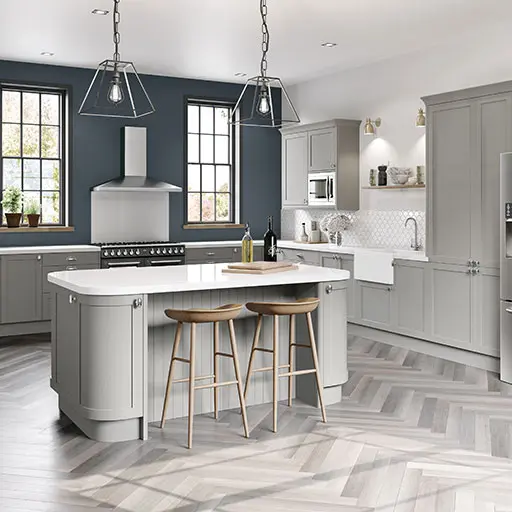The kitchen is often considered the heart of the home, a place where families gather, meals are prepared, and memories are made. With the rise of DIY culture and custom design, many homeowners are now looking to build their own kitchens. This journey not only allows for personalization but also gives you the opportunity to create a functional and beautiful space tailored to your unique needs. In this guide, we’ll walk you through the steps to build your own kitchen, covering everything from initial planning to the final touches.
Understanding the Importance of a Well-Designed Kitchen
Before diving into the practicalities of building your kitchen, it’s essential to understand why a well-designed kitchen is crucial:
- Functionality: A thoughtfully designed kitchen enhances workflow, making cooking and entertaining more enjoyable. The layout, storage, and accessibility of tools and ingredients all play a role in how efficiently you can work.
- Aesthetics: Your kitchen is a reflection of your personal style. By building your own kitchen, you have the freedom to choose colors, materials, and finishes that resonate with you and complement your home.
- Value Addition: A well-designed kitchen can significantly increase the value of your home. Potential buyers often prioritize the kitchen, and an attractive, functional space can make a lasting impression.
Step 1: Defining Your Kitchen Needs and Goals
Before you start designing, take the time to define your kitchen needs and goals. Consider the following aspects:
- Cooking Habits: Reflect on your cooking style. Do you often prepare elaborate meals, or do you prefer quick and easy recipes? Understanding your cooking habits will help determine your kitchen’s layout and features.
- Family Size: Consider how many people will regularly use the kitchen. A larger family may require more workspace, storage, and seating options.
- Lifestyle: If you entertain frequently, you might prioritize an open layout with a central island for socializing. If your kitchen is primarily for cooking, focus on functionality and efficient storage.
- Budget: Establish a budget for your kitchen build. This will guide your decisions regarding materials, appliances, and design features.
Step 2: Choosing the Right Layout
The layout of your kitchen is crucial to its functionality. Here are some popular layouts to consider:
- L-Shaped Kitchen: This design uses two adjacent walls and is ideal for small to medium spaces. It offers flexibility for adding an island or a dining area.
- U-Shaped Kitchen: Featuring three walls of cabinetry and appliances, this layout maximizes storage and workspace, making it suitable for larger kitchens.
- Galley Kitchen: A galley kitchen consists of two parallel countertops, creating a narrow but efficient workspace. This layout is excellent for smaller homes or apartments.
- Island-Centric Kitchen: An island-centric layout places a central island at the heart of the kitchen, providing additional workspace, storage, and seating options. This encourages interaction and enhances the kitchen’s social atmosphere.
- Open Plan Kitchen: Combining the kitchen with the living and dining areas, an open plan layout fosters social interaction and creates a spacious feel.
Step 3: Selecting Materials and Finishes
Choosing the right materials and finishes is essential for both aesthetics and functionality. Here are some key elements to consider:
- Cabinetry: Select cabinetry that fits your style and storage needs. Options range from traditional wood finishes to modern high-gloss materials. Consider custom cabinets for a unique look.
- Countertops: Choose durable and attractive materials for your countertops. Popular choices include granite, quartz, marble, and laminate. Think about how each material will fit into your overall design and lifestyle.
- Flooring: Consider flooring options that are practical and aesthetically pleasing. Hardwood, tile, vinyl, and laminate are common choices, each offering unique benefits in terms of durability and maintenance.
- Backsplash: A well-designed backsplash can add visual interest to your kitchen. Choose materials like tile, glass, or stainless steel to create a focal point.
- Fixtures and Appliances: Select faucets, knobs, and handles that complement your design style. Invest in high-quality appliances that meet your cooking needs and enhance the overall look of your kitchen.
Step 4: Planning for Functionality
To ensure your kitchen is both beautiful and functional, consider these practical tips:
- Work Triangle: The kitchen work triangle concept involves positioning the sink, stove, and refrigerator in a triangular layout to promote efficiency. Ensure these key areas are easily accessible from one another.
- Storage Solutions: Maximize storage by incorporating cabinets that reach the ceiling, pull-out shelves, and hidden compartments. Use open shelving for easy access to frequently used items.
- Lighting: Proper lighting is essential in a kitchen. Utilize a mix of ambient, task, and accent lighting to enhance visibility and create a warm atmosphere. Pendant lights over the island and under-cabinet lighting can provide both functionality and style.
- Appliance Placement: Position appliances for easy access and workflow. Consider built-in appliances to save space and create a sleek look.
- Zoning: Create designated zones for cooking, prep work, and dining. Use furniture placement and area rugs to define these spaces and promote a smooth flow.
Step 5: Personalizing Your Kitchen
Once you’ve established the layout and chosen materials, it’s time to add personal touches to your kitchen. Here are some ideas to help you personalize your space:
- Color Scheme: Choose a color palette that reflects your style. Consider incorporating bold colors for accents or opt for a neutral base with colorful accessories.
- Artwork and Decor: Display artwork, decorative items, or family photos to make the space feel more inviting and personal.
- Plants and Greenery: Incorporate plants or herbs to add a touch of nature and freshness to your kitchen. They can also serve as functional elements if you choose edible plants.
- Textiles: Use curtains, rugs, and cushions to soften the space and introduce texture. Choose fabrics that complement your color scheme and design style.
- Unique Features: Consider adding unique features that reflect your personality, such as a chalkboard wall for notes and recipes or a custom backsplash with a personal design.
Step 6: Seeking Professional Help
While building your kitchen can be an exciting DIY project, don’t hesitate to seek professional help if needed. Hiring a kitchen designer or contractor can provide valuable expertise and streamline the process. They can help you refine your ideas, make recommendations, and ensure that your kitchen meets local building codes.
Step 7: Bringing Your Kitchen Design to Life
Once you have your design plan finalized, it’s time to bring your vision to life. Follow these steps to ensure a smooth process:
- Create a Timeline: Develop a timeline for the project, outlining each phase of the build. This will help keep you organized and on track.
- Order Materials: Begin ordering materials and fixtures based on your design plan. Be sure to account for lead times, especially for custom orders.
- Hire Contractors: If you’re working with a contractor, communicate your vision clearly and ensure everyone is on the same page regarding the timeline and budget.
- Stay Involved: Throughout the build, stay involved in the process. Regularly check in with contractors, make decisions promptly, and address any issues that arise.
- Celebrate Milestones: While building can be stressful, it’s also an opportunity to create a space that reflects your style and meets your needs. Celebrate each milestone and enjoy the process.
Step 8: Maintenance and Upkeep
Once your kitchen is complete, it’s essential to maintain it to ensure it remains functional and beautiful. Here are some tips for upkeep:
- Regular Cleaning: Establish a routine for cleaning countertops, appliances, and floors. Use appropriate cleaners for different surfaces to avoid damage.
- Check Appliances: Regularly check and maintain appliances to ensure they are functioning correctly. Replace filters and clean vent hoods as needed.
- Inspect Fixtures: Periodically inspect faucets, knobs, and handles for any wear and tear. Replace or repair as necessary to keep your kitchen looking its best.
- Update Decor: Consider updating decor and accessories periodically to keep the space feeling fresh and inviting. Small changes can have a significant impact.
Conclusion: Build Your Own Kitchen with Confidence
Building your own kitchen is an exciting journey that allows you to create a space tailored to your needs and style. By carefully planning, choosing the right materials, and personalizing your design, you can craft a kitchen that enhances your home and lifestyle.
Whether you envision a modern masterpiece or a cozy farmhouse kitchen, the key is to make choices that align with your preferences. Remember that your kitchen is not just a functional space; it’s the heart of your home where memories are made.
If you’re ready to embark on this rewarding adventure, explore the possibilities and build your own kitchen today!

